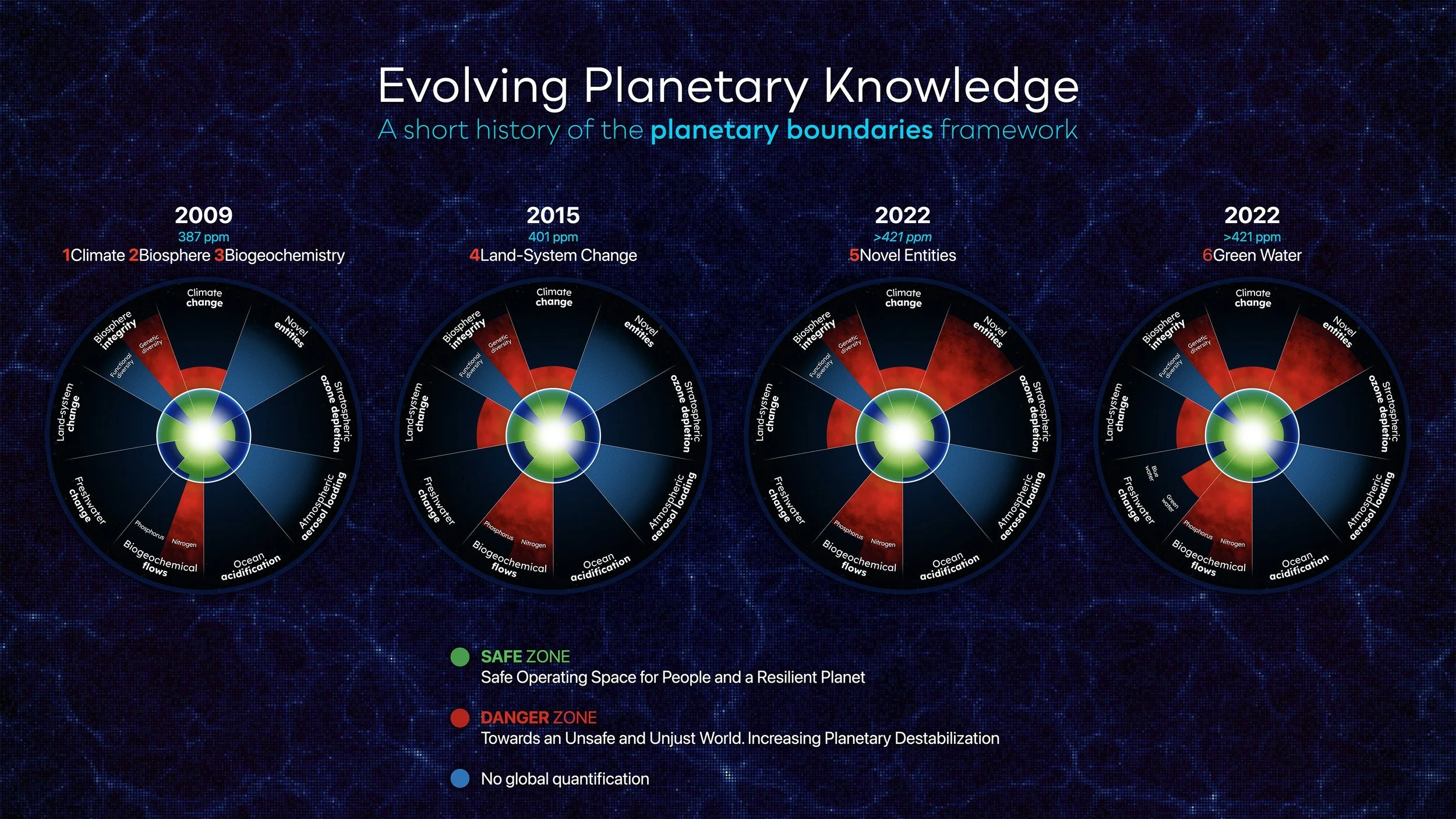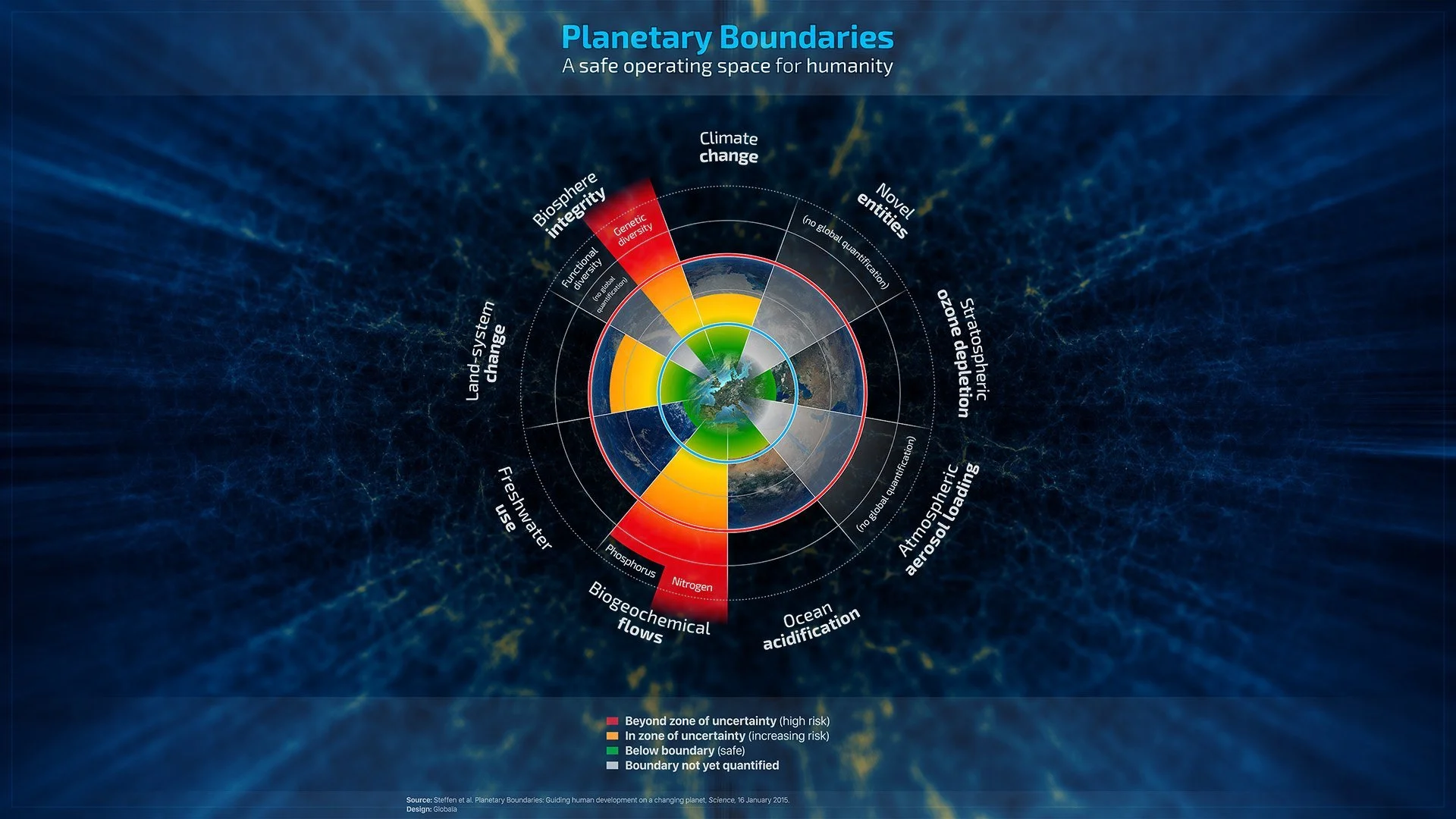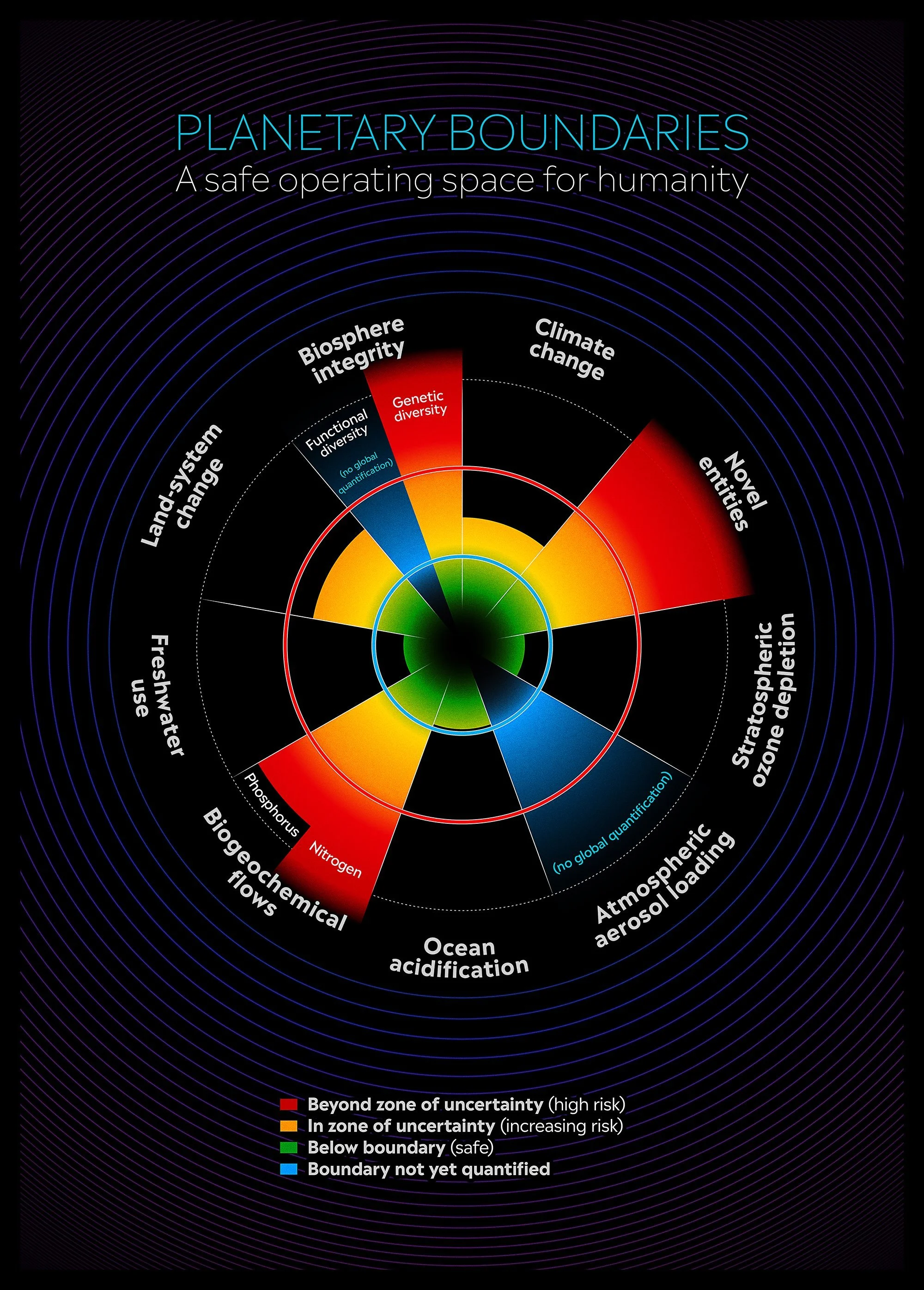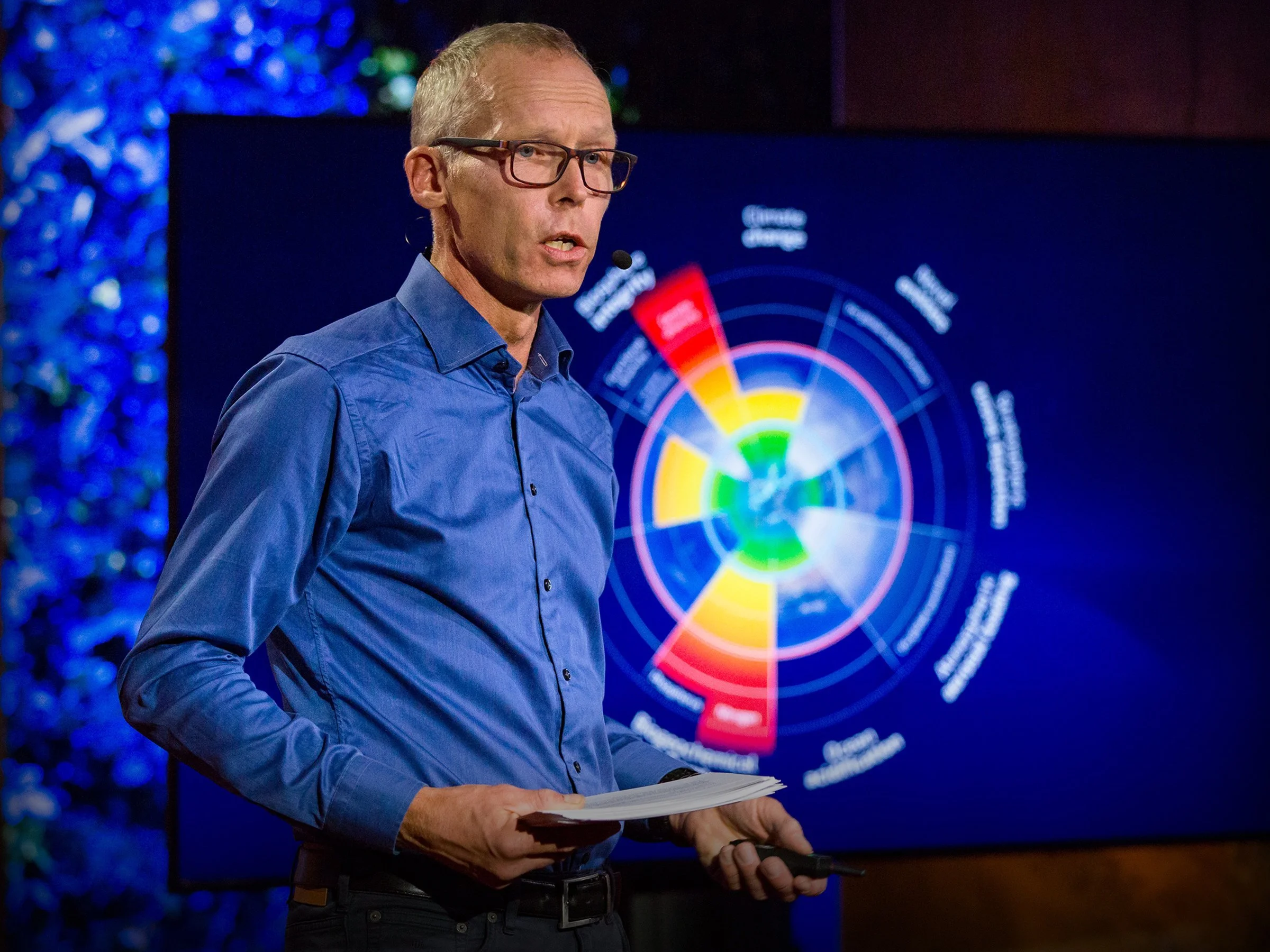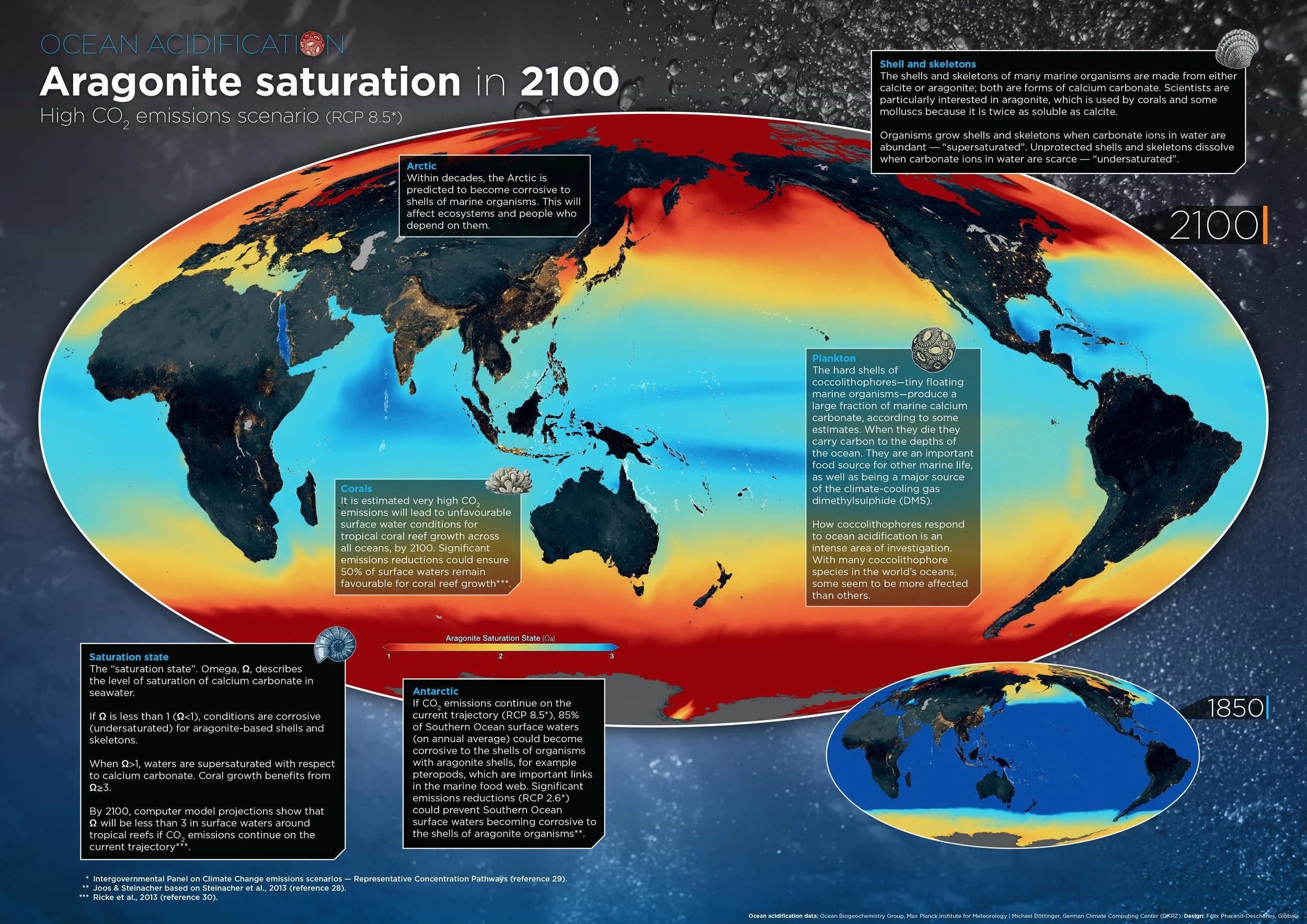🌍🚧
Stockholm Resilience Centre · Potsdam Institute for Climate Impact Research
Planetary Boundaries
🌍🥁 09.2024 The Planetary Boundaries Science is evolving!
🌍🥁 09.2024 The Planetary Boundaries Science is evolving!
Visit planetaryhealthcheck.org or our dedicated page on the 🌍🩺 Planetary Health Check to learn more.
Throughout our collaboration with the esteemed researchers at the Stockholm Resilience Centre and the Potsdam Institute for Climate Impact Research, we have been privileged to contribute to the visualisation and communication of planetary boundaries over the years.
The Planetary Boundaries framework is a groundbreaking scientific concept introduced in 2009 by a group of Earth system and environmental scientists led by Johan Rockström, who was then the director of the Stockholm Resilience Centre. Published in the journal Nature, their seminal paper identified 9 critical Earth system processes that regulate the planet’s stability and resilience. The framework is based on Complex System Science (CSS) and Earth System Science (ESS), which study the intricate interactions among Earth’s components—atmosphere, biosphere, hydrosphere, and geosphere—and how human activities impact these systems.
Planetary Boundaries
These are the thresholds or limits beyond which significant, potentially irreversible changes to Earth's ecosystems and the global environment could occur, endangering the planet's habitability.
Earth System Processes
The Planetary Boundaries are associated with 9 essential Earth system processes that help maintain the stability and resilience of the Earth system.
As of 2024, the 9 Planetary Boundaries are:
🌡️ Climate Change 🔺↗️
This boundary measures atmospheric CO2 levels and the total impact of human activities on Earth’s energy balance. The safe limit for CO2 is set at 350 ppm, while the current level is 419 ppm. Similarly, the safe level for radiative forcing is +1.0 W/m², but it has reached +2.79 W/m². These figures show that we are well beyond the safe boundary and continuing to move in the wrong direction.
🧬 Biosphere Integrity 🔺↗️
Biosphere integrity looks at genetic diversity and the health of ecosystems. For genetic diversity, the boundary is set below 10 extinctions per million species-years (E/MSY), but current rates exceed 100 E/MSY. For ecosystem health, the boundary is set at less than 10% human appropriation of net primary production (HANPP), but the current level is 30%, surpassing both safe limits. Ecosystem degradation continues to increase, posing severe risks to biodiversity.
🔬 Novel Entities 🔺↗️
This boundary addresses synthetic chemicals and pollutants introduced into the environment, including plastics and endocrine disruptors. Over 350,000 synthetic chemicals have been introduced, many of which remain untested for environmental impact. Although a specific quantitative boundary has not been set, it is recognized that we have already exceeded safe limits, with plastics alone exceeding 8.3 billion tons globally.
🌾 Biogeochemical Flows 🔺↗️
This boundary assesses the impact of human activities on nutrient cycles. The safe limit for phosphorus is 11 Tg/year globally (6.2 Tg/year regionally), but current use is 22.6 Tg/year. For nitrogen, the boundary is 62 Tg/year, while we are currently at 190 Tg/year. Both boundaries are significantly exceeded, leading to widespread water pollution, eutrophication, and “dead zones” in aquatic systems.
🌳 Land System Change 🔸↗️
This boundary monitors the percentage of original forest cover left. For tropical forests, the boundary is 85%, but current coverage is only 60%. The loss of forested land, especially in the tropics, is a critical transgression, with ongoing deforestation contributing to biodiversity loss and climate impacts.
💦 Freshwater Change 🔸↗️
Freshwater change assesses human interference in water systems. For blue water (rivers, lakes, aquifers), the safe limit is 10.2% of global land area; the current disruption is 18.2%. For green water (soil moisture and evapotranspiration), the boundary is 11.1%, but we have reached 15.8%, indicating transgressions in both blue and green water flows, driven by agricultural and industrial water use.
🐚 Ocean Acidification ✅↗️🔸
The boundary for ocean acidification focuses on the carbonate ion concentration, measured through aragonite saturation (Ωarag). The safe limit is set at 80% of preindustrial levels, and the current saturation level is close to 2.8 Ωarag, nearing the boundary. Although we remain within the boundary, acidification is a growing concern for marine ecosystems.
☁️ Atmospheric Aerosol Loading ✅↙️
This boundary looks at the difference in aerosol optical depth between hemispheres, with a safe limit of 0.1. The current value is 0.065, and it is decreasing, meaning this boundary is well within the safe zone and continuing to improve, thanks to reductions in emissions of particulate matter.
🛡️ Stratospheric Ozone Depletion ✅↔️
This boundary monitors the global average ozone concentration in Dobson Units (DU). The safe limit is a less than 5% reduction from preindustrial levels (around 276 DU). The current global ozone concentration is 285.7 DU, which means it remains within the safe zone, with ongoing recovery due to the phase-out of ozone-depleting substances under the Montreal Protocol.
We may categorize planetary boundaries into three broad groups:
🌍 Global Planetary Boundaries
🌡️ Climate, 🐚 Ocean, and 🛡️ Ozone. These boundaries affect the entire Earth system and have global-scale impacts.
🌿 Biospheric Planetary Boundaries
🧬 Biodiversity, 🌳 Land, 💦 Freshwater, and 🌾 Nutrients (nitrogen and phosphorus cycles). These boundaries primarily concern the living systems of the Earth and their interactions with the physical environment.
🧪 'Alien' Planetary Boundaries
🔬 Pollution (e.g., synthetic chemicals, genetically modified organisms) and ☁️ Aerosols. These boundaries involve human-introduced elements that are foreign to natural Earth systems.
Planetary Boundaries v3.0 (09.2023)
What’s new?
For the first time, the boundary for Novel Entities has been quantified, revealing that we have exceeded it. This includes the build-up of human-made chemicals like micro-plastics, pesticides, and nuclear waste. Additionally, scientific data is now available to measure the limit for Atmospheric Aerosol Loading. While this limit hasn't been globally surpassed, regional oversteps have been identified, such as in South Asia. The boundary concerning Freshwater now encompasses both Green Water (found in soil and plants in areas like farms and forests) and Blue Water (found in rivers and lakes), and both these limits have been breached. Another groundbreaking addition is a control variable for Biosphere Integrity, which shows that we've been exceeding this limit since the late 1800s, a period marked by significant growth in global agriculture and forestry. This study emphasises that planetary resilience encompasses much more than just Climate Change.
Reference:
Katherine Richardson et al., Earth beyond six of nine planetary boundaries. Science Advances. 9, eadh2458 (2023). DOI:10.1126/sciadv.adh2458
Planetary Boundaries v3.0 (2023)
This new visualisation of planetary boundaries was created in collaboration with the scientists from the Potsdam Institute for Climate Impact Research. It differs from Figure 1 in the paper because it uses a different normalised baseline. In Figure 1, the values from control variables are normalised such that the origin (the centre) represents mean Holocene conditions, and the planetary boundary (from green to yellow) has the same radius for all boundaries. In this visualisation, however, it is normalised so that the planetary boundary and the transition from the Increasing Risk Zone to the High Risk Zone are consistent for all boundaries. This approach was adopted in versions 1 (2009) and 2 (2015).
Related concepts
Safe Operating Space (SOS)
The "Safe Operating Space" refers to the collective range defined by scientifically-set boundary levels for nine critical biophysical systems and processes that govern Earth's life support systems. Transgressing these boundaries jeopardizes the conditions vital for human development and well-being.
Planetary Resilience
Planetary resilience refers to the Earth's capacity to maintain its vital biophysical systems and processes within safe boundaries, ensuring stability and support for life. This concept is anchored in the understanding of planetary boundaries. Transgressing these boundaries poses risks to the stability and resilience of the Earth system, potentially resulting in significant environmental damage. The objective is to maintain the Earth in a "Holocene-like" state, the only known planetary condition that has reliably supported modern human civilisation.
Holocene-like
Modern humans have thrived on Earth for about 200,000 years, enduring through Ice Ages and warm periods, predominantly as hunter-gatherers. The Holocene, which began around 12,000 years ago, marked a stable Earth state, paving the way for agriculture and modern civilisations. The Planetary Boundary framework uses this "Holocene-like" state as a reference to understand how much planetary change can be tolerated without jeopardising conditions similar to those of the Holocene, which are known to support our current world. This approach is exemplified by the climate planetary boundary being set at 350 ppm CO2, instead of the original Holocene level of 280 ppm.
Tipping Points 🌍⚖️
Tipping points refer to thresholds where critical components of the Earth system can shift into a drastically different state, whereas planetary boundaries are limits beyond which risks to the Earth's systems become unsafe. While crossing a planetary boundary doesn't necessarily mean surpassing a tipping point, the concept of tipping points informs the establishment of these boundaries to ensure the Earth's systems remain stable and interlinked processes are considered.
Our dedicated page: globaia.org/tipping
Safe and Just Earth System Boundaries 🌍🕊️
The recent Earth system boundaries (ESB) assessment expands upon the planetary boundaries framework by integrating concepts like climate justice, doughnut economics and the Sustainable Development Goals. The ESBs emphasise a safe and just operating space and prioritise scaling quantitative boundaries across local to global levels. Developed by the Earth Commission, the ESBs aim to prevent significant harm to individuals by identifying eight specific control variables for five core planetary processes, serving as the foundation for actionable, science-based targets at regional and local scales.
Our dedicated page: globaia.org/safeandjust
References:
PB v1.0 · Seminal 2009 Nature paper: A safe operating space for humanity
PB v2.0 · 2015 Science paper: Planetary boundaries: Guiding human development on a changing planet
PB v3.0 · 2023 Science Advances paper: Earth beyond six of nine planetary boundaries
Newly assessed Novel Entities boundary: Outside the Safe Operating Space of the Planetary Boundary for Novel Entities
New assessed Green Water boundary: A planetary boundary for green water
Other relevant project: Breaking Boundaries — The Science of Our Planet
Planetary boundaries in the Anthropocene, from 1950 to 2020.
Created in collaboration with the Potsdam Institute for Climate Impact Research.
Same data but two ways of visualising it. In the left-hand side figure, the values for control variables are normalised to the mean Holocene conditions (centre) and the upper limit of the Safe Operating Space. In the right-hand side one, values for control variables are normalised to the upper limit of the Safe Operating Space and the transition from the Increasing Risk Zone to the High Risk Zone.
Pre-2023 Work on Planetary Boundaries
The updated Planetary Boundaries framework (2022), showing the newly assessed boundary for ‘novel entities’ (aka chemical pollution), as well as the distinction between ‘blue water’ (freshwater use of rivers, lakes, reservoirs and renewable groundwater stores) and ‘green water’ (terrestrial precipitation, evaporation and soil moisture). For simplicity, this version does not show the ‘zone of uncertainty’.
REF: https://pubs.acs.org/doi/10.1021/acs.est.1c04158 & https://www.nature.com/articles/s43017-022-00287-8
Planetary Boundaries 2009-2022 | From 3 to 6 boundaries crossed — The evolution of this influential scientific framework over time.
Ocean pH in 2100
According to projections based on current trends in greenhouse gas emissions and ocean acidification, by 2100, the global average ocean pH is expected to decrease by 0.3-0.4 units, resulting in a more acidic marine environment. This significant shift in ocean chemistry, driven primarily by increased absorption of anthropogenic carbon dioxide, will have profound impacts on marine ecosystems, biodiversity, and the overall health of the world's oceans, posing significant challenges to the sustainability of our planet's marine life and resources
Aragonite saturation in 2100
Aragonite saturation is a key parameter in ocean chemistry that reflects the concentration of aragonite, a form of calcium carbonate, in seawater. It is an essential measure of the ability of marine organisms, such as shellfish, corals, and some plankton, to build and maintain their shells or skeletons. Projections for 2100, based on various emission scenarios, suggest that the global average aragonite saturation state will continue to decline.





